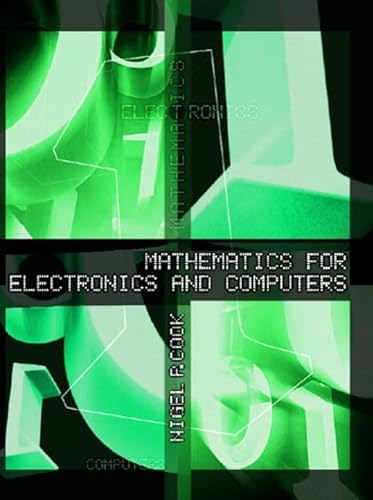Mathematics for Electronics and Computers - Softcover

"synopsis" may belong to another edition of this title.
With 12 textbooks; 23 editions, and 20 years of front-line education experience, best-selling author Nigel Cook has written this text as a complete math course for high school, community college, or vocational/technical college students seeking a career in electronics and computer technology.
This finely tuned, carefully tested, and accuracy checked volume is organized into three parts:
- PART A: Basic Math
- Fractions; Decimal Numbers; Positive and Negative Numbers; Exponents and the Metric System; Algebra, Equations, and Formulas; Geometry and Trigonometry; and Logarithms and Graphs
- PART B: Electronics Math
- Current and Voltage; Resistance and Power; Series DC Circuits; Parallel DC Circuits; Series-Parallel DC Circuits and Theorems; Alternating Current (AC); Capacitors; Inductors and Transformers; RLC Circuits and Complex Numbers; and Diodes and Transistors
- PART C: Computer Math
- Analog to Digital; Number Systems and Codes; Logic Gates; Boolean Expressions and Algebra; Binary Arithmetic; and Introduction to Computer Programming
Text Features
As with any topic to be learned, the method of presentation can make a big difference between clear comprehension and complete confusion. Employing an "integrated math applications' approach, this text reinforces all math topics with extensive applications to show the student the value of math as a tool. Therefore, if the need for math is instantly demonstrated, the tool is retained.
Some additional features include:
- Student-friendly writing style
- Integrated math applications
- Section self-test evaluation points
- Circuit analysis tables
- Extensive end-of-chapter test bank
- Humanistic vignettes
- Worked-out examples
- Calculator sequence examples
- Proto-board pictorials
- Margin term definitions
INTRODUCTION
Since World War II no branch of science has contributed more to the development of the modern world as electronics. It has stimulated dramatic advances in the fields of communication, computing, consumer products, industrial automation, test and measurement, and health care. It has now become the largest single industry in the world, exceeding the automobile and oil industries, with annual sales of electronic systems greater than $2 trillion. One of the most important trends in this huge industry has been a gradual shift from analog electronics to digital electronics. This movement began in the 1960s and is almost complete today. In fact, a recent statistic stated that, on average, 90% of the circuitry within electronic systems is now digital, and only 10% is analog. This digitalization of the electronics industry is merging sectors that were once separate. For example, two of the largest sectors or branches of electronics are computing and communications. Being able to communicate with each other using the common language of digital has enabled computers and communications to interlink, so that computers can now function within communication-based networks, and communications networks can now function through computer-based systems. Industry experts call this merging convergence and predict that digital electronics will continue to unite the industry and stimulate progress in practically every field of human endeavor.
Mathematics is interwoven into the very core of science, and therefore an understanding of mathematics is imperative for anyone pursuing a career in technology. As with any topic to be learned, the method of presentation can make a big difference between clear comprehension and complete confusion. Employing an "integrated math applications" approach, this text reinforces all math topics with extensive electronic and computer applications to show the student the value of math as a tool; therefore, if the need is instantly demonstrated, the tool is retained.
OUTLINE
After 12 textbooks, 21 editions, and 19 years of front-line education experience, best-selling author Nigel Cook has written Mathematics for Electronics and Computers as a complete math course for technology students. To assist educators in curriculum chapter selection, the text has been divided into three parts to give it the versatility to adapt to a variety of course lengths.
Part A: Basic Math
- Chapter 1: Fractions
- Chapter 2: Decimal Numbers
- Chapter 3: Positive and Negative Numbers
- Chapter 4: Exponents and the Metric System
- Chapter 5: Algebra, Equations, and Formulas
- Chapter 6: Geometry and Trigonometry
- Chapter 7: Logarithms and Graphs
Part B: Electronics Math
- Chapter 8: Current and Voltage
- Chapter 9: Resistance and Power
- Chapter 10: Series DC Circuits
- Chapter 11: Parallel DC Circuits
- Chapter 12: Series-Parallel DC Circuits and Theorems
- Chapter 13: Alternating Current (AC)
- Chapter 14: Capacitors
- Chapter 15: Inductors and Transformers
- Chapter 16: RLC Circuits and Complex Numbers
- Chapter 17: Diodes and Transistors
Part C: Computer Math
- Chapter 18: Analog to Digital
- Chapter 19: Number Systems and Codes
- Chapter 20: Logic Gates
- Chapter 21: Boolean Expressions and Algebra
- Chapter 22: Binary Arithmetic
- Chapter 23: Introduction to Computer Programming
SUPPLEMENTS
- Instructor's Solutions Manual (ISBN 0-13-048778-3)
- Test Item File (ISBN 0-13-049025-3)
- PH Test Manager (ISBN 0-13-048779-1)
- Companion Website: http://www.prenhall.com/cook
"About this title" may belong to another edition of this title.
- PublisherPrentice Hall
- Publication date2002
- ISBN 10 0130811629
- ISBN 13 9780130811622
- BindingPaperback
- Edition number1
- Number of pages784
Buy New
Learn more about this copy
Shipping:
US$ 4.00
Within U.S.A.
Top Search Results from the AbeBooks Marketplace
Mathematics for Electronics and Computers
Book Description Paperback. Condition: new. New. Fast Shipping and good customer service. Seller Inventory # Holz_New_0130811629

